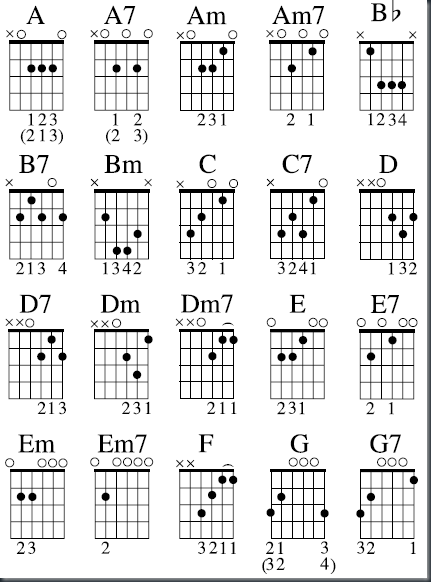For your final, you will need to:
1. Label notes on staff
2. Draw chord diagrams (I will draw the frets and lines to match the diagrams below instead of written as a mirror)
3. Compare and contrast recordings
4. Match vocabulary words to their definitions
5. Identify rhythms and their note values
6. Perform an excerpt from the method book (sight-reading)
From http://www.guitarlessons.com/guitar-lessons/guitar-theory-ear-training-and-reading/how-to-read-sheet-music/
Being able to read music is a great skill that every guitar player should at least try to acquire. Reading on the guitar can be pretty difficult for some players. Many guitar players start trying to learn how to read only to get frustrated and quit. This lesson will cover the very basics of how to start reading music on the guitar. We will mainly cover the names of the lines and spaces on the treble clef. 
Guitar music is written on the treble clef. You can identify a treble clef by looking for the squiggly G looking character at the beginning of each line of music. If you look at a piece of sheet music you will see a series of 5 lines and 4 spaces. The musical alphabet is A B C D E F and G. Each of these lines and spaces correspond to one of the letters in the musical alphabet. The lowest line on the staff is an E. The lowest space on the staff is an F. If you continue up each line and space you will just go through the musical alphabet in order. When you come to a G note just start over on A again for the next note.
“Every Good Boy Does Fine”. To remember the names of the spaces just remember the word “FACE”. This is how almost everyone learns to remember the names of the lines and spaces. It may seem a bit difficult to remember the names of each line and space at first, but if you work at it on a regular basis it will start to become second nature.
Play the F note on the 3rd fret of the 4th string of the guitar. This is the F note on the 1st space of the treble clef. You could also play this same F note on the 8th fret of the 5th string or the 13th fret of the 6th string. When you are reading music on the guitar, most notes have multiple places that you could choose to play them. This is one of the things that make reading music on the guitar so difficult.
guitar so difficult.
For this lesson just concentrate on getting familiar with the names of the lines and spaces on the treble clef. Remember “Every Good Boy Does Fine” for the lines and “FACE” for the spaces. Once you are familiar with the lines and spaces, start trying to find those notes on the guitar fretboard.
Once you have learned how to read sheet music, you should learn how to read chord diagrams, how to read guitar rhythms, how to read guitar tabs, and how to read chord charts!

Vocabulary words:
Beat
Rhythm
Tempo
strumming
standard notation
chords
melody
harmony
verse
chorus
Relative minor
Major scale
Transpose
I
IV
V
V7
12-Bar Blues
Arpeggio
For the sight-reading, you will get something similar to the following excerpt. It will have chords and notes, and you should be able to play both.
For comparing and contrasting recordings, practice your skills listening to the jazz charts on the concert band study page.
No comments:
Post a Comment